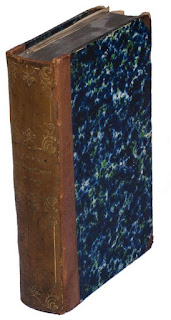Handbook of field fortification by the German mathematician and military writer Carl Friedrich Peschel (1793-1852). It is divided into three parts, the first dealing with the theory behind field fortifications, the second with their execution, and the third with the tactics of defence and offence.
Saturday, January 18, 2020
Friday, January 10, 2020
Geschichte des Deutschen Freiheitskrieges vom Jahre 1813 bis zum Jahre 1815 by Friedrich Richter
(1st Volume)
(2nd Volume)
(3rd Volume)
(4th Volume)
"Uniformenkunde" by Richard Knötel
Richard Knotel was born in Glogau, Germany in 1857. He was a German artist and expert in the study of European Military Uniforms History. Richard Knötel developed an interest in military fashion and history at a very young age. His strong interest in European military history has motivated him to research military installations of different empires and its uniforms. “Uniformenkunde by Richard Knotel” is a huge collection of illustration plates of the armies of Europe from the 17th century to 1914. The Uniformenkunde book is still an important piece of reference on the subject of military attire up to today.
Richard Knötel (January 12, 1857 – April 26, 1914)
Saturday, January 4, 2020
Briefe des westfälischen Stabsoffiziers, Friedrich Wilhelm von Lossberg vom russischen Feldzug des Jahres 1812.
Letters from the Westphalian staff officer, Friedrich Wilhelm von Lossberg, of the Russian campaign of 1812.
Main Author: Lossberg, Friedrich Wilhelm von, 1776-1848.
Related Names: Meyer, Christian 1842-
Language(s): German
Published: Berlin, R. Eisenschmidt, 1910.
The History of the Hessian Hussar
"The History of the Hessian Hussar," authored by Carl von Kossecki and Robert Freiherr von Wrangel, is a meticulously researched chronicle of the Royal Prussian 2nd Hessian Hussar Regiment No. 14 and its ancestral Hessian troops from 1706 to 1886. This historical account traces the evolution of the Hessian Hussars of Hesse-Cassel, beginning from the early formation of the Husaren-Compagnie, through its development into the Husaren-Corps, and ultimately culminating in the establishment of the Husaren-Regiment as it stood in 1821.
The book provides an in-depth look at the origins, transformations, and significant milestones of this renowned military unit. It delves into the intricate details of the regiment's organization, tactical developments, and the role it played in various military engagements throughout its history. The authors, with their detailed narrative and comprehensive analysis, bring to life the valor and discipline of the Hessian Hussars, highlighting their contributions to the military history of the region.
Rich in historical detail and analysis, "The History of the Hessian Hussar" is an invaluable resource for historians, military enthusiasts, and anyone interested in the evolution of cavalry tactics and the legacy of the Hessian military tradition in European warfare. 478 pages.
PURCHASE
Thursday, January 2, 2020
True presentation and report of the English-Dutch and grand alliance generals, chiefly the Duke of Marlborough, Fieldmarshal d'Ouwerkerck and his serene highness the crown prince of Hessen-Cassel breaking of the enemy lines on the Maas river on July 18, 1705
Birds-eye view print shows plan of the battlefied with troop locations between Mechelen and Loeven. Depiction of the battle outside of Hallishem, Belgium between the Gete and Meus (Maas) rivers. Key activities in the print are labeled 1-5. On July 18, 1705, the Duke of Marlborough and allied generals successfully broke through the French forces holding the Lines of Brabant at the small village of Elixham in Belgium. The Lines of Brabant were a strategic arc of defensive fieldworks stretching from Antwerp to Namur in Belgium.
Subscribe to:
Comments (Atom)
















